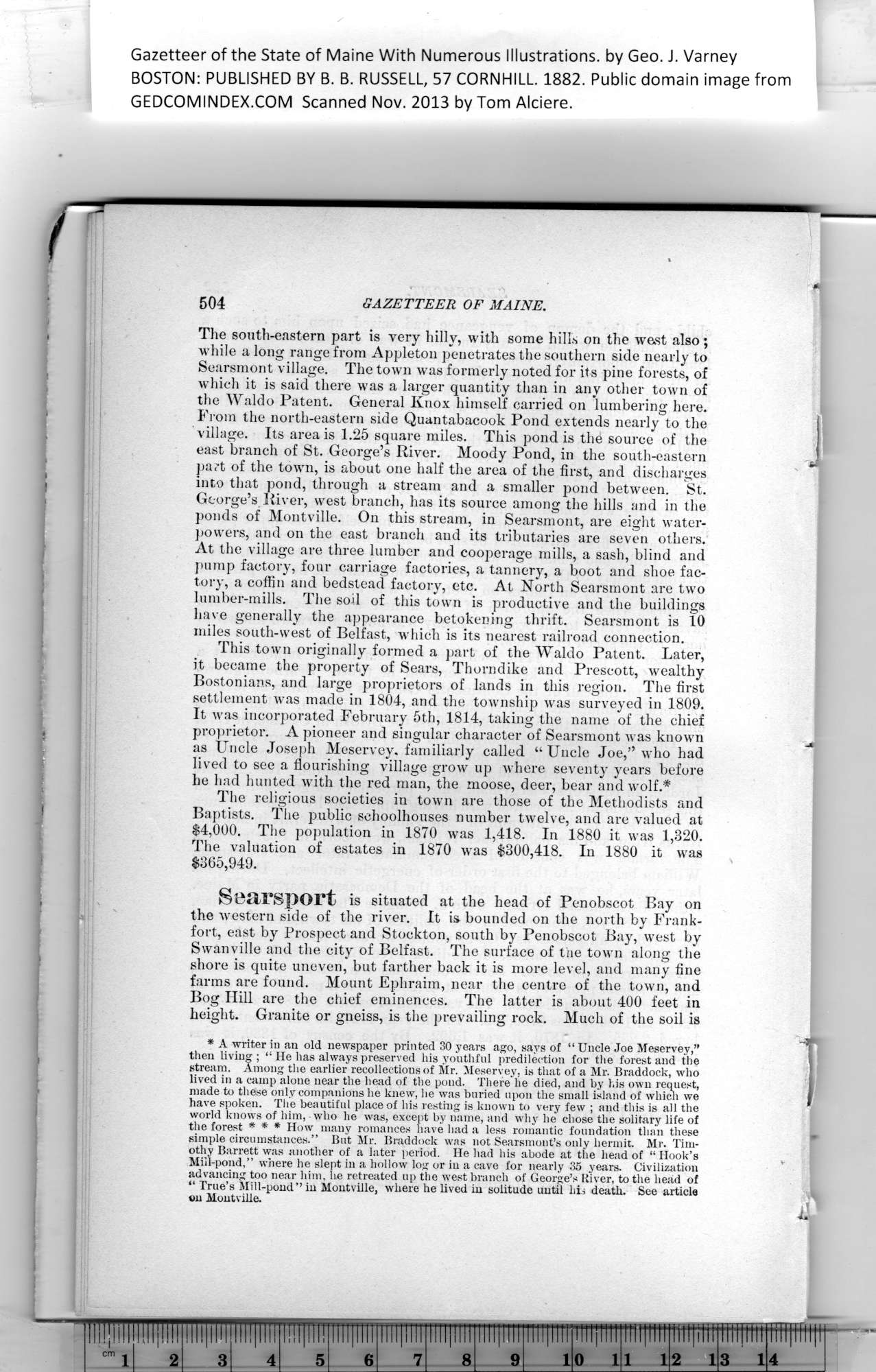|
Gazetteer of the State of Maine With Numerous Illustrations, by Geo. J. Varney
BOSTON: PUBLISHED BY B. B. RUSSELL, 57 CORNHILL. 1882. Public domain image from
GAZETTEER OF MAINE.
The south-eastern part is very hilly, with some hill's on the west also ;
while a long range from Appleton penetrates the southern side nearly to
Searsmont village. The town was formerly noted for its pine forests, of
which it is said there was a larger quantity than in any other town of
the Waldo Patent. General Knox himself carried on lumbering here.
From the north-eastern side Quantabacook Pond extends nearly to the
village. Its area is 1.25 square miles. This pond is the source of the
east branch of St. George’s River. Moody Pond, in the south-eastern
part of the town, is about one half the area of the first, and discharges
into that pond, through a stream and a smaller pond between. St.
George’s River, west branch, has its source among the hills and in the
ponds of Montville. On this stream, in Searsmont, are eight water-
powers, and on the east branch and its tributaries are seven others.
At the village are three lumber and cooperage mills, a sash, blind and
pump factory, four carriage factories, a tannery, a boot and shoe fac-
tory, a coffin and bedstead factory, etc. At North Searsmont are two
lumber-mills. The sod of this town is productive and the buildings
have generally the appearance betokening thrift. Searsmont is 10
miles south-west of Belfast, which is its nearest railroad connection.
This town originally formed a part of the Waldo Patent. Later,
it became the property of Sears, Thorndike and Prescott, wealthy
Bostonians, and large proprietors of lands in this region. The first
settlement was made in 1804, and the township was surveyed in 1809.
It was incorporated February 5th, 1814, taking the name of the chief
proprietor. A pioneer and singular character of Searsmont was known
as Uncle Joseph Meservey. familiarly called “Uncle Joe,” who had
lived to see a flourishing village grow up where seventy years before
he had hunted with the red man, the moose, deer, hear and wolf.1
The religious societies in town are those of the Methodists and
Baptists. The public schoolhouses number twelve, and are valued at
$4,000. The population in 1870 was 1,418. In 1880 it was 1,320.
The valuation of estates in 1870 wras $300,418. In 1880 it was
$365,949.
Searsport is situated at the head of Penobscot Bay on
the western side of the river. It is bounded on the north by Frank-
fort, east by Prospect and Stockton, south by Penobscot Bay, west by
Swanville and the city of Belfast. The surface of the town along the
shore is quite uneven, but farther back it is more level, and many fine
farms are found. Mount Ephraim, near the centre of the town, and
Bog Hill are the chief eminences. The latter is about 400 feet in
height. Granite or gneiss, is the prevailing rock. Much of the soil is
1
A writer in an old newspaper printed 30 years ago, says of “ Uncle Joe Meservey,”
then living; “ He has always preserved his youthful predilection for the forestand the
stream. Among the earlier recolleetious of Mr. Meservey, is that of a Mr. Braddock, who
lived in a camp alone near the head of the pond. There he died, and by his own request,
made to these only companions he knew, he was buried upon the small island of which we
have spoken. The beautiful place of bis resting is known to very few ; and this is all the
world knows of him, who he was, except by name, and why lie eliose the solitary life of
the forest * * * How many romances have had a less romantic foundation than these
simple circumstances.” But Mr. Braddock was not Searsmont’s only hermit. Mr. Tim-
othy Barrett was another of a later period. He had his abode at the head of “ Hook’s
Mill-pond,” where he slept in a hollow log or in a cave for nearly 35 years. Civilization
advancing too near him, lie retreated up the west branch of George’s River, to the head of
“ True’s Mill-pond” in Montville, where he lived in solitude until bis death. See article
on Montville.
PREVIOUS PAGE ... NEXT PAGE
This page was written in HTML using a program written in Python 3.2
|
